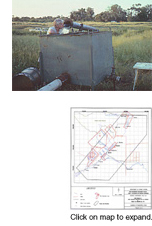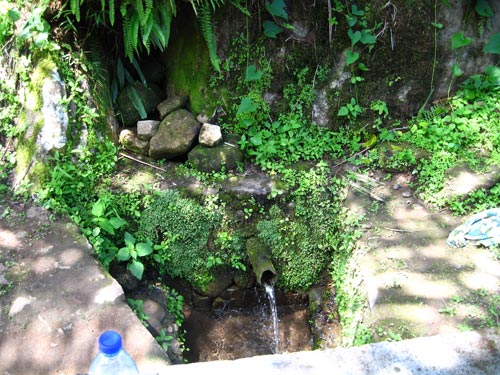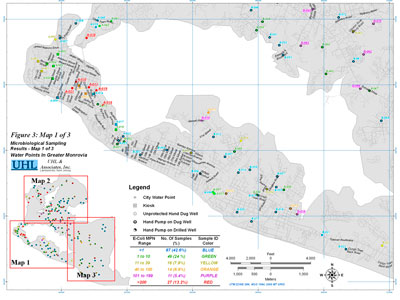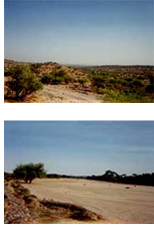INTERNATIONAL CASE STUDIES - AFRICA
CASE STUDIES: BOTSWANA, CAMEROON, LIBERIA, SOMALILAND
| BOTSWANA |
CLIENT: |
Department of Water Affairs, Republic of Botswana |
|
PROJECT: |
Maun Groundwater Development Project
Phase 1: Exploration and Resource Assessment |
|
LOCATION: |
Maun, Botswana
|
|
 The joint venture of Vincent Uhl Associates, Inc. and Water Resource Consultants (Pty) Ltd. (WRC) was contracted by the Department of Water Affairs, Government of Botswana to conduct a groundwater resource assessment and development feasibility study for a 5,000 square mile area in northwest Botswana with the objective of securing a safe sustainable source for the town of Maun to the year 2030. The study area is on the fringes of the Okavango Delta, one of the largest inland deltas in the world. The study was initiated after a major dam project proposed by Snowy Mountain Engineering Corp (SMEC) of Australia on behalf of the government was terminated after a critical review by the IUCN (International Union for the Conservation of Nature). The study area is primarily in and on the fringes of the Kalahari Desert. Prior to the study, freshwater resources were thought to be very limited and confined to near perennial and seasonal water courses. The joint venture of Vincent Uhl Associates, Inc. and Water Resource Consultants (Pty) Ltd. (WRC) was contracted by the Department of Water Affairs, Government of Botswana to conduct a groundwater resource assessment and development feasibility study for a 5,000 square mile area in northwest Botswana with the objective of securing a safe sustainable source for the town of Maun to the year 2030. The study area is on the fringes of the Okavango Delta, one of the largest inland deltas in the world. The study was initiated after a major dam project proposed by Snowy Mountain Engineering Corp (SMEC) of Australia on behalf of the government was terminated after a critical review by the IUCN (International Union for the Conservation of Nature). The study area is primarily in and on the fringes of the Kalahari Desert. Prior to the study, freshwater resources were thought to be very limited and confined to near perennial and seasonal water courses.
UHL and WRC headed the project team which was comprised of 30 technical experts, including professors at the University of Botswana in the fields of remote sensing, vegetation analysis, geomorphology, structural geology, surface water hydrology, hydrogeochemistry, isotope studies, geophysics, hydrogeology, geology, artificial recharge, economics, cost engineering and ecology.
The project resulted in the identification of several new aquifer sources that can be utilized for water supply to Maun and the region well into the 21st century.
Principal Technical Activities:
- Groundwater exploration using airborne geophysics (magnetic and electromagnetic); satellite imagery interpretation and surface geophysical studies to identify areas for field drilling exploration.
- Groundwater resource investigation through the installation of 50 test wells. Aquifer pumping tests were run on 46 wells. Two deep bedrock test wells were installed to depths of 1,000 and 247 meters to evaluate groundwater development potential and water quality conditions in deeper bedrock aquifer systems.
- Groundwater development feasibility and sustainability analysis through aquifer modeling; recharge analysis; and groundwater-surface water interaction study.
- Supplementary project activities included: artificial recharge feasibility studies; groundwater modeling; isotope studies and seismic monitoring.
Download PDF of the Phase 1 Executive Summary
BACK TO TOP |
|
|
CLIENT: |
Water Resources Consultants (Pty) Ltd. & Department of Water Affairs
Republic of Botswana |
|
PROJECT: |
Maun Groundwater Development Project
Phase 2: Resource Assessment and Wellfield Development |
|
LOCATION: |
Maun,
Botswana |
|
 Vincent Uhl Associates, Inc. was retained by Water Resources Consultants (Pty) Ltd. from 2001 to 2004 to assist in the Phase 2 Maun Groundwater Development Project. This Project Phase involved the siting and installation of two production wellfields to provide water to the town of Maun and surroundings. UHL provided technical expertise in the areas of aquifer recharge assessment; drilling specification development and well design; modeling; groundwater sustainability assessments; and hydro-geochemical analysis. Vincent Uhl Associates, Inc. was retained by Water Resources Consultants (Pty) Ltd. from 2001 to 2004 to assist in the Phase 2 Maun Groundwater Development Project. This Project Phase involved the siting and installation of two production wellfields to provide water to the town of Maun and surroundings. UHL provided technical expertise in the areas of aquifer recharge assessment; drilling specification development and well design; modeling; groundwater sustainability assessments; and hydro-geochemical analysis.
We also developed a Wellfield Management Plan including operational water quality and quantity monitoring parameters.
Download PDF of the Phase 2 Final Report
BACK TO TOP |
|
| CAMEROON |
CLIENT: |
Engineers
without Borders |
|
PROJECT: |
Pro
Bono Assistance to the University of Pennsylvania |
|
LOCATION: |
Northwest
Province, Cameroon |
|
Vincent Uhl mentored engineering students from the University of Pennsylvania during an assessment phase evaluation of potential sources for village water supply systems.
Mr. Uhl assisted students in the villages of Kop and Gundom in the Northwest Province in the evaluation of spring sources that are now being used for a permanent piped water supply system. Springs were identified, their flows measured, and water quality samples were collected and analyzed. Two springs were selected in each village for development. Piping systems were mapped in the field and planning proceeded for the coordination of system installation on a subsequent trip.

BACK TO TOP |
|
| LIBERIA |
CLIENT: |
World Bank Liberia Water Sanitation Program (WSP) & Liberia Department of Public Works |
|
PROJECT: |
Urban and Semi- Urban Water Point Sampling Project |
|
LOCATION: |
Monrovia, Liberia |
|
UHL & Associates, Inc. in association with the University of the Free State, South Africa and EDEN Preferred Water Services of Monrovia, Liberia sampled 202 water points in the capital city of Monrovia. The collected samples were analyzed for:
- Field parameters (collected at water point): Electrical Conductivity (EC), pH, Temperature (T), Oxidation Reduction Potential (ORP), and Dissolved Oxygen (DO).
- Microbiological Parameters (analyzed in field laboratory in Monrovia): Heterotrophic plate counts (HPC), Total Coliform, and E-Coli.
- Inorganic and Organic Chemical Parameters (analyzed at the
University of Free State analytical laboratories in Bloemfontein, South Africa): Anions [Cl, SO4, NO3, F, B, PO4]; Cations [Ca, Mg, Na, K]; Metals [Al, As, Cr, Cu, Fe, Mn, Pb, Zn]; and TOC.
Principal Activities:
- Identifying a subset of 200 water points from a dataset of 1000+ water points to represent the range of source types including hand-dug wells (protected and not protected), drilled wells, city supplied standpipes and kiosks.
- Developing recommendations for short, mid and long-term water quality improvement.
- Organizing workshops to educate involved government agencies and interested non-government agencies.
- Sampling the 200 water points and training locals on relevant sampling procedures, quality control.
- Preparing maps showing Total Coliform and E-Coli contamination, and Inorganic and Organic chemical parameters.

Download PDF of the Case Study
BACK TO TOP |
|
| SOMALILAND |
CLIENT: |
Hargeisa Water
Authority
|
|
PROJECT: |
Assessment of City of
Hargeisa Wellfield
|
|
LOCATION: |
Hargeisa, Somaliland
|
|
 The Hargeisa Water Authority has an exceptionally challenging mission to keep the water supply flowing into Hargeisa, the largest population center and seat of government in Somaliland. This hillside metropolis of over 300,000 people obtains its water from a wellfield located in the Ged Dheeble valley about 20 kilometers distant from the city. The Hargeisa Water Authority has an exceptionally challenging mission to keep the water supply flowing into Hargeisa, the largest population center and seat of government in Somaliland. This hillside metropolis of over 300,000 people obtains its water from a wellfield located in the Ged Dheeble valley about 20 kilometers distant from the city.
UHL was contracted by WorldWater Corporation to evaluate the wellfield, and the distribution system from the wellfield to the City. The City's water supply system was installed by the Chinese Government in the early 1970's and expanded in 1986-88. The system was designed to deliver 8,000 to 10,000 m3/day (2 to 2.5 million gallons per day). Water extracted from twelve production boreholes is pumped through two twin underground 300 mm diameter pipelines over a 20 km distance and 260 m elevation to in-ground storage tanks overlooking the city.
Due to damage to the system during civil war in the late 1980's, only six production boreholes were operative at the time of the study. Our evaluation involved an analysis and testing of the six production boreholes; an assessment of requirements to reactivate the 6 boreholes that had been in operation for over a decade, and the outline of a program for additional groundwater exploration in nearby basins. We also outlined the elements of a program to evaluate recharge to the aquifer system supplying the city, and initiated a water-level and water-quality monitoring program for the water utility.
BACK TO TOP |
|
|

![]() T: +1 (609) 947-1703
T: +1 (609) 947-1703